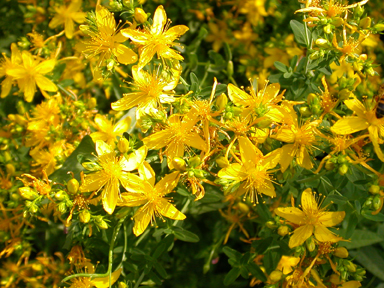 The composition of secondary metabolites of Saint John’s wort (Hypericum perforatum, SJW) varies according to growth conditions and vegetative stage. We determined the quantity and qualitative composition of SJW oil by GC-MS at three vegetative stages: before flowering, at full flowering, and at the time of fruit formation.
The composition of secondary metabolites of Saint John’s wort (Hypericum perforatum, SJW) varies according to growth conditions and vegetative stage. We determined the quantity and qualitative composition of SJW oil by GC-MS at three vegetative stages: before flowering, at full flowering, and at the time of fruit formation.
Results: Whereas fresh and dry yield of biomass per hectare was highest at the time of fruit formation, SJW in full flowering gave the highest amounts of essential oil (0.35 ml/100 g of dry matter) as compared to earlier (0.12 ml/100 g) respectively later vegetative stages (0.16 ml/100g). Major constituents of the essential oil of SJW of all vegetative stages are bicyclogermacrene, alpha-cadinol and spathulenol.
Bicyclogermacrene shows a distinct peak at full flowering as compared to early or late stages. β-Caryophyllene and γ-muurolene are only present in major amounts in early flowering, whereas α-cadinene is indicative for full flowering, and β-bisabolene respectively globulol for late flowering stages. γ-Eudesmol sharply decreases after full flowering. Longifolene is not present in full flowering, but present in very high amounts (18.71 respectively 21.99 %) in early respectively late flowering. In case these results – obtained with the cultivar „Topas” from a closely defined region – could be generalized, these compounds might be used as a quality parameter for essential oils from SJW. The analytical results would suggest the stage of full flowering as the optimal harvesting time, in accordance with traditional use of SJW.
Download Poster: 53rd Annual Congress of the Society for Medicinal Plant Research, Florence (Italy), August 21-25, 2005
Download additional data for Hypericum GC

